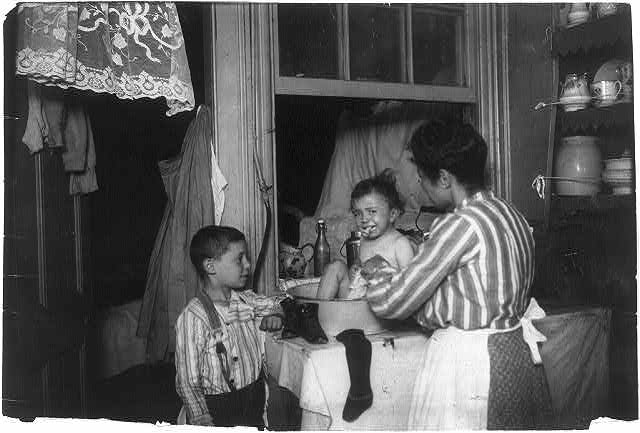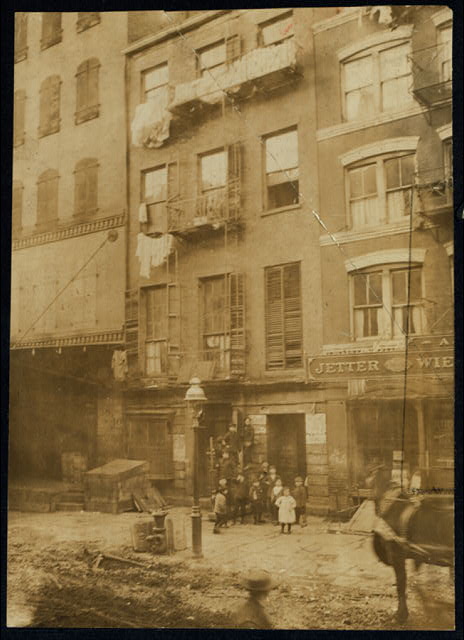Schimmel Wood Carvings-Tidbits
Wilhelm Schimmel (1817-1890) was a German itinerant who lived in Cumberland County during the last quarter of the 19th century. In exchange for food and lodging, often in people’s barns, he made wood carvings for them.


Top: The tenement bath tub. Photoprint copyrighted by Bertha H. Smith, 1905. https://lccn.loc.gov/2003655419
Bottom: Tenement house with children in front. Possibly 36 Laight St. Location: New York, New York. https://hdl.loc.gov/loc.pnp/nclc.04078
On Tuesday, August 19, 1884, a train left New York City with 100 children bound for the Cumberland Valley. They were “Fresh Air Fund” children; a movement started by Pennsylvania clergyman Willard Parsons in 1877. The goal of the ‘Fresh Air Fund” was to bring poor children from the tenements of New York City to the country for fresh air, good food and the sights and sounds of rural life for two weeks during the summer.
Reverend Parsons worked in concert with the New York Post and finally the Tribune newspaper. The Tribune provided security for the money contributed to the fund as well as office space for the manager of the fund. The Fund provided for transportation of the children only. It relied on church ministers and pastors to solicit families to feed and house the children.
The children were selected solely with reference to their poverty and their need for fresh air and good food. They had to be clean, free from contagious diseases and between the ages of 8 and 12.1
When the children arrived in Harrisburg from New York City on Tuesday, August 19, 1884, Thomas B. Kennedy, the President of the Cumberland Valley Railroad, transferred them to two special cars to finish their journey. The Shippensburg Chronicle described the children’s arrival in flowery language. “Thirty pairs of little legs made the descent from the cars to the ground in short order at Carlisle. Miss Kate Irvin had the matter in charge at that place. Homes on large farms had been provided for most of the children and they were sent off to them in groups of six and eight. Several were kept by families in town.”
“At Shippensburg a crowd of about 500 people filled the platform eager to see the sixty-three little boys and girls who were lifted down from the train at that point. They were marched quickly into the depot where the waiting rooms had been locked to keep out the crowd. Only the children and their entertainers were allowed to enter, so the work of distribution was soon over. The hosts are all substantial people who live in comfortable homes and are willing and able to give their poor little guests such a fortnight of pure happiness as they never before enjoyed.” 2
The New York Tribune correspondent who accompanied the children wrote about the experiences of some of them. “Many of the children were out riding the day after their arrival. One boy, as he proudly held the reins, remarked….’It’s great fun now. I like to steer a horse; never did it before, and she steers beautifully around the curves. I felt real bad the first night, coming among strangers, but I’m all right now.’”3
Riding, fishing, and hiking were just some of the things that many of the children experienced for the first time. Many had never seen a mountain or a farm animal. With all this outdoor activity, there were bound to have been some mishaps. One of the children who stayed with Harry Mountz in the summer of 1888 had two of his teeth knocked out by a horse.4
Their two weeks in the country over, about 100 Fresh Air Fund children left the C.V.R.R. station on Tuesday morning, September 2, 1884, witnessed by a large crowd, reported the Shippensburg Chronicle. “So strongly had these little folks become attached to their kind patrons that they were very loath to leave, and many of them shed tears at their departing. During their stay they were treated with the greatest kindness, were well cared for, most of them re-clothed, and they will no doubt long remember their trip to the Cumberland Valley.” The Sentinel expressed the belief that “those of our people who had them were pleased with the experiment and willing to try it again next summer.” 5
The Fresh Air Fund is still in existence. Since its inception in 1877 it has provided summer outings for more than 1.8 million New York City children from low-income communities.
Wilhelm Schimmel (1817-1890) was a German itinerant who lived in Cumberland County during the last quarter of the 19th century. In exchange for food and lodging, often in people’s barns, he made wood carvings for them.
[1] Sentinel, Carlisle, August 5, 1884; Carlisle Weekly Herald, August 21, 1884.
[2] Shippensburg Chronicle, September 5, 1884.
[3] Ibid.
[4] Carlisle Weekly Herald, August 4, 1888.
[5] Sentinel, Carlisle, September 2, 1884.